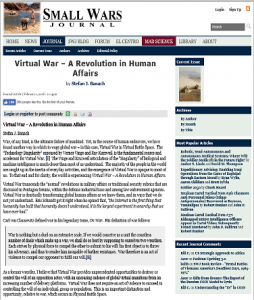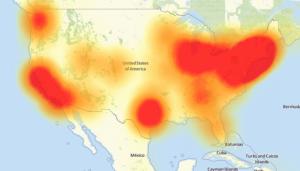 (Editor’s Note: Originally published under the same title in Small Wars Journal, Mad Scientist Laboratory is pleased to present Part II of our guest post by COL(R) Stefan J. Banach, distilling the essence of his original article. Part I may be read here.)
(Editor’s Note: Originally published under the same title in Small Wars Journal, Mad Scientist Laboratory is pleased to present Part II of our guest post by COL(R) Stefan J. Banach, distilling the essence of his original article. Part I may be read here.)
Framing and naming the Virtual War paradigm is a challenge for leaders today. The United States’ leaders, who have responsibility to win the Nation’s wars, have lost personal mastery for warfare in our time.  The U.S. is fighting the wrong war, with the wrong policies, strategies, doctrine, tactics, techniques, and procedures. The logic for warfare in our time is askew, as we have seen at previous junctures in history. The value of mechanization versus the horse and the application of air power on modern battlefields during the 1919-1939 inter-war period are notable historical examples where new technological advantages were not immediately appreciated by “the experts.”
The U.S. is fighting the wrong war, with the wrong policies, strategies, doctrine, tactics, techniques, and procedures. The logic for warfare in our time is askew, as we have seen at previous junctures in history. The value of mechanization versus the horse and the application of air power on modern battlefields during the 1919-1939 inter-war period are notable historical examples where new technological advantages were not immediately appreciated by “the experts.”

The entity that controls the Virtual Domain and masters Virtual War Campaigning first, will indirectly achieve social control, and will win every war they engage in, at pennies on the dollar.


Invoking Sun Tzu is appropriate, as he summed up the goal of Social Control in this quote,
“The supreme art of war is to subdue the enemy without fighting.”
 Global “Social Control” is possible for the first time in the history of the world. Burgeoning Social Control capabilities are nested in: global satellite imagery, swarms of civilian and military aerial drones, public camera surveillance systems in our “smarter cities,” iPhone tracking protocols, Fitbit devices, the internet, artificial intelligence, DNA, Social Security numbers, Driver’s License numbers, Credit Reports, online personal health records, and all the associated digital, personal, and financial contrivances which exist today.
Global “Social Control” is possible for the first time in the history of the world. Burgeoning Social Control capabilities are nested in: global satellite imagery, swarms of civilian and military aerial drones, public camera surveillance systems in our “smarter cities,” iPhone tracking protocols, Fitbit devices, the internet, artificial intelligence, DNA, Social Security numbers, Driver’s License numbers, Credit Reports, online personal health records, and all the associated digital, personal, and financial contrivances which exist today.
 In the years ahead, the Social Control challenge will become acute as every human being will potentially have bio-medical nanotechnologies embedded in them to ensure optimal health. Each of these medical Nano devices will have a digital interface that presents both new opportunities for increased wellness and new vulnerabilities. Humans will be susceptible to the traditional biological viruses which exist today. New technologies will need to be developed to protect us from artificial virus “infections” that could be mass transmitted in targeted societies, using the embedded Nano medical implants that will serve as the host within our bodies.
In the years ahead, the Social Control challenge will become acute as every human being will potentially have bio-medical nanotechnologies embedded in them to ensure optimal health. Each of these medical Nano devices will have a digital interface that presents both new opportunities for increased wellness and new vulnerabilities. Humans will be susceptible to the traditional biological viruses which exist today. New technologies will need to be developed to protect us from artificial virus “infections” that could be mass transmitted in targeted societies, using the embedded Nano medical implants that will serve as the host within our bodies.
 Metaphorically, the overwhelming propensity for Physical Battle Space Maneuver is the United States’ modern-day Maginot Line. Like the French from 1919-1939, the U.S. has spent more money than all of its Allies combined in the Global War on Terrorism (GWOT) since 2001, executing Physical Battle Space Maneuver activities.
Metaphorically, the overwhelming propensity for Physical Battle Space Maneuver is the United States’ modern-day Maginot Line. Like the French from 1919-1939, the U.S. has spent more money than all of its Allies combined in the Global War on Terrorism (GWOT) since 2001, executing Physical Battle Space Maneuver activities.  Like the French prior to WWII, the United States’ leadership is preparing for the last war it won and does not see the Virtual Blitzkrieg that is upon it every day. There is an ongoing complete envelopment of all the significant U.S. national interests by way of Virtual War – or – Virtual Battle Space Maneuver, and it is happening right in front of us.
Like the French prior to WWII, the United States’ leadership is preparing for the last war it won and does not see the Virtual Blitzkrieg that is upon it every day. There is an ongoing complete envelopment of all the significant U.S. national interests by way of Virtual War – or – Virtual Battle Space Maneuver, and it is happening right in front of us.
Creating an effective Virtual War acumen requires a systemic reframe of leadership development and the creation of non-standard doctrine, tactics, techniques and procedures for how our national security forces and law enforcement agencies compete in Virtual Space.
Virtual Space is the decisive terrain and securing it is the decisive operation.
For additional information on Russian and Chinese initiatives to win the Virtual War, download and review Timothy L. Thomas’ works addressing these topics at the Foreign Military Studies Office (FMSO) Bookshelf.
COL(R) Stefan J. Banach concluded his military service as the U.S. Army’s 11th Director of the School of Advanced Military Studies (SAMS). As the SAMS Director, he led the development of the initial Design Methodology concepts and doctrine for the U.S. Army from 2007-2010. He is a Distinguished Member of the 75th Ranger Regiment and served in that organization for nine years, culminating with command of the 3rd Ranger Battalion from 2001-2003.


